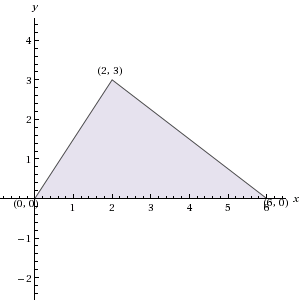All SAT Math Resources
Example Questions
Example Question #135 : Geometry
Solve each problem and decide which is the best of the choices given.
Solve for 

To solve for 

All triangles' angles add up to 
So subtract 



Angles 


Subtract 




Example Question #136 : Geometry

Refer to the above figure. Evaluate 














and substituting:
Example Question #137 : Geometry

Figure is not drawn to scale.
Refer to the provided figure. Evaluate 






Setting 


Example Question #2 : Acute / Obtuse Triangles
If a = 7 and b = 4, which of the following could be the perimeter of the triangle?

I. 11
II. 15
III. 25
I and II Only
II and III Only
I, II and III
I Only
II Only
II Only
Consider the perimeter of a triangle:
P = a + b + c
Since we know a and b, we can find c.
In I:
11 = 7 + 4 + c
11 = 11 + c
c = 0
Note that if c = 0, the shape is no longer a trial. Thus, we can eliminate I.
In II:
15 = 7 + 4 + c
15 = 11 + c
c = 4.
This is plausible given that the other sides are 7 and 4.
In III:
25 = 7 + 4 + c
25 = 11 + c
c = 14.
It is not possible for one side of a triangle to be greater than the sum of both of the other sides, so eliminate III.
Thus we are left with only II.
Example Question #141 : Sat Mathematics
Which of the following measurements can NOT represent the sides of a triangle.
Given the Triangle Inequality, the sum of any two sides of a triangle must be greater than the third side.
Given the measurements 
Therefore, these lengths cannot represent a triangle.
Example Question #111 : Triangles
If triangle ABC has vertices (0, 0), (6, 0), and (2, 3) in the xy-plane, what is the area of ABC?
9
20
18
12
10
Example Question #252 : Plane Geometry
The height, 



If 



Using the formula for the area of a triangle (


Example Question #141 : Geometry
Find the height of a triangle if the area of the triangle = 18 and the base = 4.
4
9
6
1
9
The area of a triangle = (1/2)bh where b is base and h is height. 18 = (1/2)4h which gives us 36 = 4h so h =9.
Example Question #251 : Plane Geometry


The perimeter is equal to the sum of the three sides. In similar triangles, each side is in proportion to its correlating side. The perimeters are also in equal proportion.
Perimeter A = 45” and perimeter B = 135”
The proportion of Perimeter A to Perimeter B is 
This applies to the sides of the triangle. Therefore to get the any side of Triangle B, just multiply the correlating side by 3.
15” x 3 = 45”
10” x 3 = 30“

Example Question #111 : Triangles
A triangle has sides of length 8, 13, and L. Which of the following cannot equal L?
6
4
15
9
7
4
The sum of the lengths of two sides of a triangle cannot be less than the length of the third side. 8 + 4 = 12, which is less than 13.
Certified Tutor
All SAT Math Resources













































